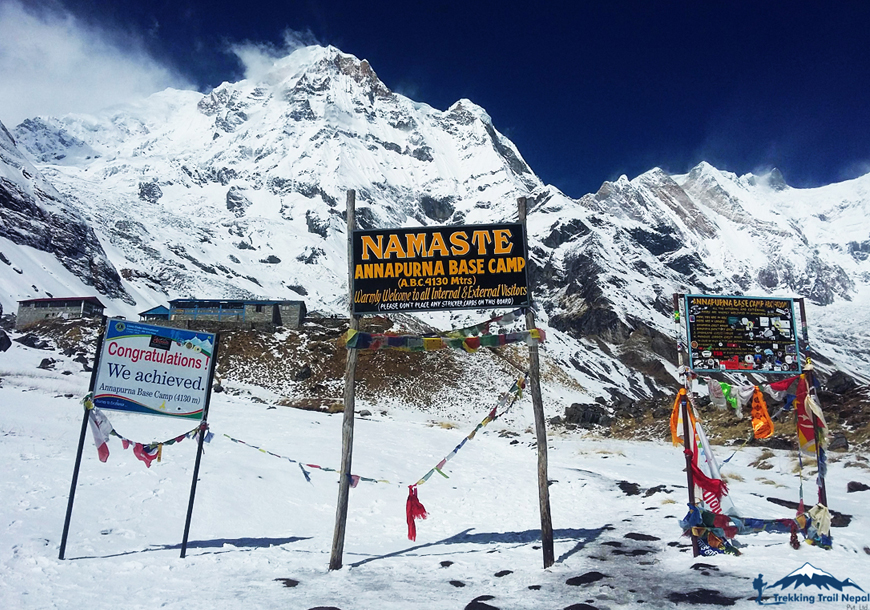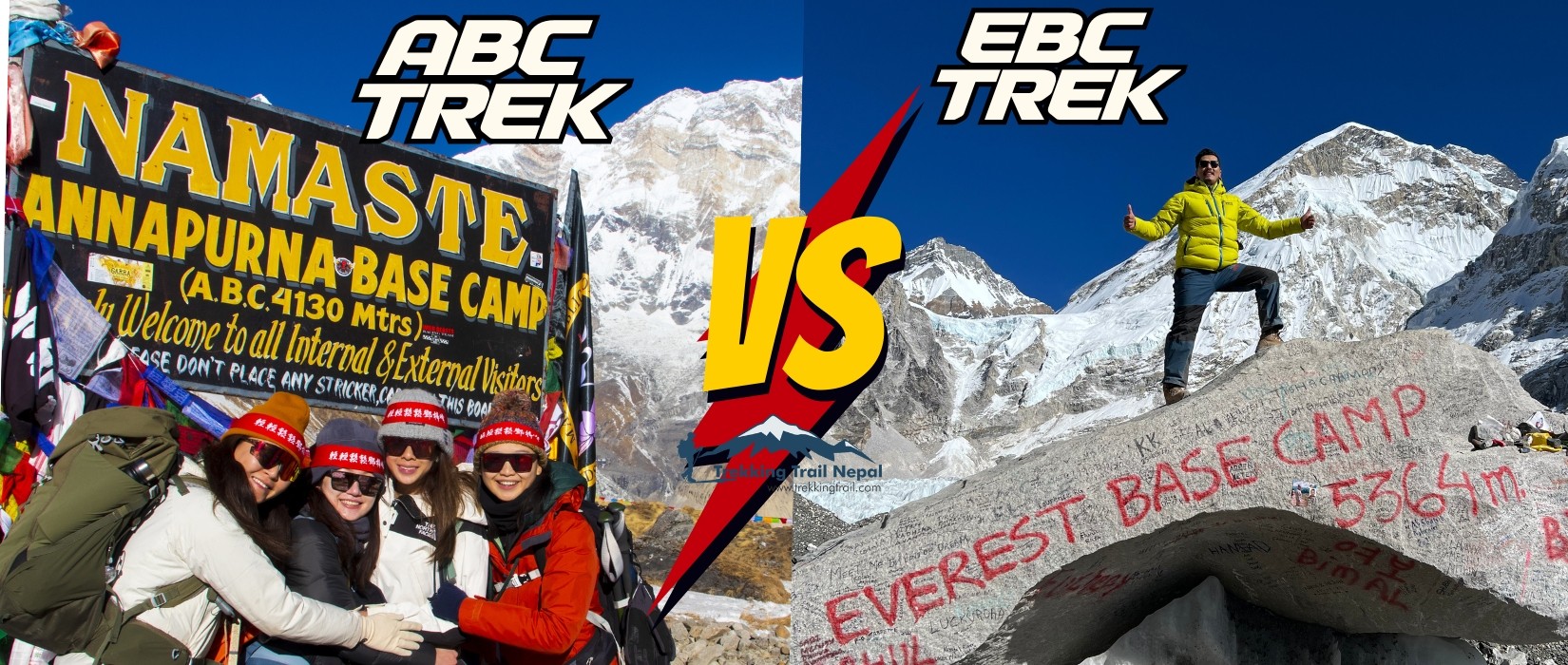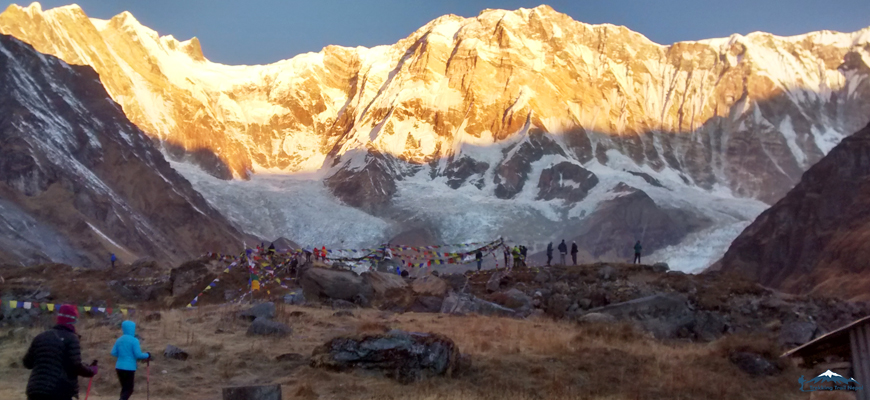Annapurna vs. EBC: Which Trek is Difficult?
Introduction to Annapurna and Everest Base Camp Treks
When it comes to trekking in Nepal, two names always stand out: Annapurna and Everest Base Camp (EBC). These iconic treks offer some of the most breathtaking views and challenging routes for adventurers. But how do they compare when it comes to difficulty? ABC Trek vs. EBC Trek!
Annapurna offers a diverse landscape, leading trekkers through lush forests, terraced fields, and remote villages before reaching the stunning high-altitude terrain of the Annapurna Sanctuary. It is a trek that not only tests your physical endurance but also allows you to experience the rich cultural heritage of the region.
On the other hand, the Everest Base Camp trek is synonymous with the ultimate trekking experience. Traversing through the Khumbu Valley, trekkers encounter glaciers, suspension bridges, and Sherpa villages. The route ultimately leads to the base of the world's highest mountain, Mount Everest. Completing this trek not only demands physical fitness but also mental resilience.
Both treks have their unique allure and set of challenges, making it essential to compare different aspects like terrain, elevation, climate, and infrastructure to determine which one is tougher. This detailed guide aims to do just that, helping you make an informed decision for your next trekking adventure.
By understanding the key differences and challenges between Annapurna and Everest Base Camp, you'll be better prepared to choose the trek that suits your fitness level and interests. Keep reading as we delve deeper into the specifics of each trek, offering insights that will help you prepare for this once-in-a-lifetime experience.
Terrain and Elevation: Annapurna vs. EBC
When comparing the terrains and elevations of the Annapurna Circuit and the Everest Base Camp (EBC) trek, it is clear both routes present distinct challenges and exhilarating experiences. For trekkers, understanding these differences can help in preparing for the journey ahead.
The Annapurna Circuit, known for its diverse landscapes, takes you through rice paddies, subtropical forests, and rugged mountainous terrain. The route gradually ascends, often requiring trekkers to traverse steep inclines and descend through deep valleys. One of the most notable terrains on this trek is the Thorong La Pass, which stands at an elevation of 5,416 meters (17,769 feet). This high-altitude pass is among the trickiest parts of the trek, demanding good acclimatization and physical endurance.
In contrast, the Everest Base Camp trek, starting from Lukla, gradually climbs up through picturesque Sherpa villages, dense forests, and arid mountain landscapes. The trail to EBC consistently climbs, leading trekkers through the imposing Khumbu Glacier and eventually reaching an altitude of 5,364 meters (17,598 feet) at the base camp. While the elevation gain is significant, the terrain itself tends to be more rugged and rocky compared to the Annapurna Circuit.

Both treks offer unique physical demands: Annapurnas' varied terrain can be more physically taxing due to its frequent ascents and descents, while EBCs' elevation can impact trekkers faster, making proper acclimatization essential.
In summary, while both terrains challenge in different ways, the choice between Annapurna and EBC depends on individual preferences for variety versus consistent altitude gain. Either way, the experience is bound to be rewarding for any avid trekker.
Climate and Weather Challenges
Trekking through either Annapurna or Everest Base Camp (EBC) presents unique climatic and weather-related challenges that can significantly impact your journey.
In the Annapurna region, you will experience a diverse range of weather conditions due to variations in altitude and terrain. Lower elevations bring warm, temperate weather, while higher altitudes, such as the Thorong La Pass, can be much colder and susceptible to sudden snowstorms. Pre-monsoon (April-May) and post-monsoon (September-October) seasons offer the most stable weather, but even then, you need to be prepared for rapid weather changes. Rain and snow can make trails slippery and more difficult to navigate.
In contrast, the EBC trek is more consistently cold, given its higher average elevation. The weather here is notoriously unpredictable, often changing from bright sunshine to blizzard-like conditions within hours. The best months for EBC trekking are similar to Annapurna: pre-monsoon (March-May) and post-monsoon (September-November). However, the colder temperatures at high altitudes, especially in places like Gorak Shep and Kala Patthar, can be harsh, challenging your endurance and gear.
Both treks demand a well-thought-out strategy for dealing with climate and weather challenges. Proper layering, waterproof gear, and thermal clothing are essential. While Annapurna offers a mix of climates that may provide some relief, EBCs' consistent cold can be relentless, presenting a different type of challenge.
Understanding the climate and weather for each trek will help you prepare better, ensuring a safer and more enjoyable experience. Are you more adaptable to changing weather, or can you endure consistent cold? Your preference might just guide you to the tougher trek for you.
Altitude Acclimatization and Health Risks
Altitude acclimatization stands as one of the most crucial aspects when comparing the Annapurna and Everest Base Camp (EBC) treks. Both treks take you to significant heights, but the way your body adjusts to these elevations can dramatically influence your experience.
The Everest Base Camp trek begins at Lukla (2,860 meters) and climbs to EBC at 5,364 meters. This rapid ascension means that trekkers must take extra time to acclimatize, with designated rest days at Namche Bazaar and Dingboche to prevent altitude sickness. Common symptoms like headaches, nausea, and dizziness can severely affect your trek if not properly managed. Severe cases can escalate to Acute Mountain Sickness (AMS), High Altitude Pulmonary Edema (HAPE), or High Altitude Cerebral Edema (HACE), all of which require immediate descent and medical attention.
On the other hand, the Annapurna Circuit trek presents a more gradual climb, starting at a lower altitude of 800 meters in Besisahar and reaching a peak at Thorong La Pass (5,416 meters). Despite the gradual ascent, trekkers are not immune to altitude-related issues. The high point at Thorong La is notorious for its challenging conditions and potential weather extremes, magnifying the risk of AMS. Acclimatization days in acclimatization villages like Manang are essential to reducing health risks.
Thus, both treks present distinct acclimatization challenges. EBC's rapid elevation gain requires careful planning and adherence to acclimatization days, while Annapurnas' staggering altitude at Thorong La demands vigilance and precaution. Proper acclimatization practices, such as staying hydrated, avoiding alcohol, and ascending slowly, are key to staying healthy and enjoying your trekking adventure.
Trekking Infrastructure and Support Systems
When comparing the trekking infrastructure and support systems of the Annapurna and Everest Base Camp (EBC) treks, a nuanced picture emerges. Both treks are well-established, yet they offer distinct experiences and amenities that cater to different preferences and needs.
The Everest Base Camp trek benefits from its longstanding popularity among hikers, resulting in a robust network of teahouses, lodges, and restaurants along the route. The Nepali government has invested substantially in maintaining this route, making it relatively easy for trekkers to find accommodation and food at various points. Moreover, medical facilities, including emergency evacuation services, are more accessible on the EBC trek, thanks to the higher volume of trekkers and the region’s tourism infrastructure.
On the other hand, the Annapurna trek presents a slightly different scenario. While it also boasts a well-developed network of teahouses and lodges, the region is noted for its natural beauty and relative solitude compared to EBC. The Annapurna Circuit and Annapurna Sanctuary treks are renowned for their diverse landscapes and cultural richness, offering a blend of high-altitude trekking and comfortable accommodations. However, the trekking path can be more challenging to navigate due to less frequent signage, and certain sections may not have the same level of support facilities as the EBC route.

In summary, if you prioritize a trek with comprehensive facilities and support systems, the Everest Base Camp trek might be more suitable. However, if you seek a blend of infrastructure and unspoiled nature, the Annapurna trek could offer a more enriching experience. Both treks have their unique charms and challenges, making the choice largely dependent on individual preferences and preparedness.
In between of ABC and EBC Trek there is another popular trek with is better in all sides: Manaslu Base Camp Trek.
Conclusion: Which Trek is tougher? ABC or EBC
Deciding whether the Annapurna Circuit or the Everest Base Camp (EBC) trek is tougher isn't straightforward, as both offer unique challenges and rewards. However, your level of trekking experience and personal preferences can significantly influence which trek you find more demanding.
The Annapurna Circuit is renowned for its diverse terrain, ranging from lush sub-tropical forests to high-altitude deserts. The trek's highest point, the Thorong La Pass, stands at 5,416 meters (17,769 feet) and demands excellent physical fitness and acclimatization. The varying weather conditions, from humid valleys to bone-chilling mountain tops, add to the complexity of the trek. Additionally, the longer duration and remote sections of the Annapurna Circuit can be mentally and physically taxing.

On the other hand, the trek to Everest Base Camp, although less varied in terrain, poses its own set of difficulties. The altitude challenge is formidable, with EBC sitting at 5,364 meters (17,598 feet). Trekkers often experience acute altitude sickness, which requires careful acclimatization. The rugged paths, extreme cold, and thinner air make the journey rigorous. However, the EBC trek is generally more accessible, with better-developed infrastructure and support systems, including more frequent rest stops and teahouses.
Ultimately, if you seek a trek with diverse landscapes and are ready for longer days of walking and varying climates, Annapurna might be tougher for you. Conversely, if altitude and its associated risks are your main concerns, Everest Base Camp could pose the greater challenge. Regardless of your choice, both treks are exhilarating and are sure to push your limits, rewarding you with breathtaking views and an unforgettable experience.
Why Travel with us
-
The company run by Local Expert with years of experiences in the Nepalese Himalaya. Management and staffs knows each nook and cranny of the country that you love to see and experience.
-
We offer Best Price for every holiday packages with ultimate value for your money and guaranteed this with quality of services on every adventure holidays with qualified field staffs.
-
We create a custom holidays itinerary for your dream trip to Nepal and Bhutan which fits in your adventure level, time frame, budget, services, and extension you looking for extra fun.



 Local Base Operator
Local Base Operator